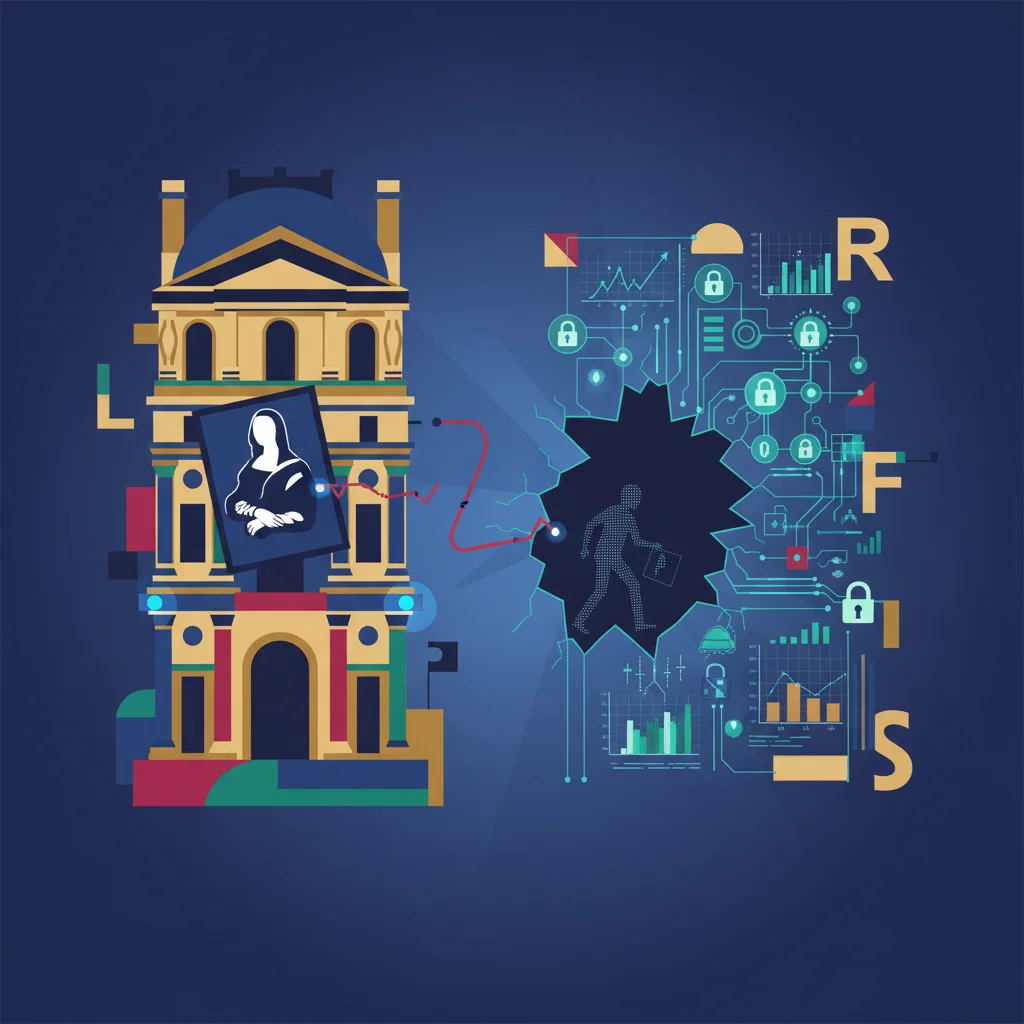
The Louvre Principle: What a Low-Tech Art Heist Teaches Modern Finance About High-Tech Risk
The Unseen Flaw in the Fortress
In the world of high-stakes security, the Musée du Louvre in Paris stands as a fortress. It’s a bastion of culture protected by layers of cutting-edge technology, round-the-clock surveillance, and a reputation for being impregnable. Yet, one of its most infamous heists wasn’t the work of a sophisticated syndicate wielding futuristic gadgets. Instead, it was a crime of audacious simplicity, a “lo-fi” masterpiece of opportunism that left officials reeling. What made the robbery so mortifying, as noted in a Financial Times analysis, was that the thieves “made it look so simple.”
This incident, while belonging to the world of art, offers a profound and urgent lesson for the modern financial landscape. In an era dominated by the race for technological supremacy—from AI-driven trading algorithms and quantum-resistant cryptography to the decentralized promise of blockchain—we have built our own digital Louvres. Our global economy and banking systems are fortified by billions of dollars in advanced security. Yet, like the famed museum, our greatest vulnerabilities may not lie where we expect. The most significant threats are often not complex cyber-warfare, but the financial equivalent of a side door left unlocked: human error, procedural gaps, and the elegant simplicity of social engineering. This is the Louvre Principle—the recognition that complexity is not a synonym for security, and the most devastating risks are often the ones hiding in plain sight.
Anatomy of a “Simple” Failure: The Parallels in Financial Security
The success of the Louvre heist wasn’t about disabling a laser grid; it was about understanding and exploiting the human element. It hinged on observing patrol schedules, identifying procedural blind spots, and leveraging the simple fact that even the most advanced systems are operated and maintained by fallible people. The thieves didn’t break the system; they simply walked through the gaps that already existed within its design and operation.
This exact dynamic plays out daily in the world of finance. While institutions pour capital into sophisticated fintech solutions to thwart hackers, the most common and effective attack vectors remain remarkably low-tech. According to Verizon’s 2023 Data Breach Investigations Report, a staggering 74% of all breaches involved the human element, including errors, misuse, or social attacks (source). The corporate firewall, the encrypted database, and the multi-signature wallet are all formidable. But they can be rendered useless by a single employee clicking on a phishing link or being tricked into revealing their credentials.
Consider the modern financial institution. It’s a technological marvel. Transactions are processed in microseconds, risk is modeled by complex AI, and assets are secured on distributed ledgers. Yet, the initial point of failure in many of the largest financial cybercrimes is disarmingly simple:
- Phishing and Social Engineering: An email that appears to be from a senior executive urgently requesting a wire transfer.
- Credential Stuffing: Using passwords stolen from a low-security website to access a high-value corporate account.
- Insider Threats: A disgruntled employee exploiting their legitimate access for malicious purposes.
These are not high-tech assaults that break cryptographic algorithms. They are “lo-fi” attacks that exploit trust, urgency, and inattention—the very same human factors the Louvre thieves capitalized on. We’ve built digital fortresses but often forget to train the guards or check if the keys have been copied.
The High Cost of Overlooking the Obvious
The illusion of complexity creates a false sense of security. When a company spends millions on a state-of-the-art security platform, the leadership team may understandably believe they are protected. However, this investment can be undermined by a single, simple oversight. The global average cost of a data breach in 2023 was $4.45 million, a 15% increase over 3 years, according to a report by IBM (source). A significant portion of these costs stems from breaches initiated by low-tech means.
This table illustrates the stark contrast between our high-tech defenses and the simple vulnerabilities that often bypass them, a core lesson from the “lo-fi charm” of the Louvre heist.
| High-Tech Financial Defense | Corresponding Low-Tech Vulnerability |
|---|---|
| AI-Powered Fraud Detection Systems | Socially engineered “urgent” payment request that bypasses standard checks. |
| Immutable Blockchain Ledger | Phishing attack to steal a user’s private wallet keys. |
| Advanced Network Firewalls & Intrusion Detection | Employee using a weak, reused password for a critical system. |
| Biometric Authentication (Face/Fingerprint ID) | “Shoulder surfing” a PIN code used as a backup authentication method. |
| Complex Algorithmic Trading Models | A “fat-finger” data entry error causing a flash crash in the stock market. |
The table highlights a critical asymmetry: we invest exponentially more in technological complexity, while attackers often achieve their goals by targeting the simplest points of failure. This isn’t an argument against technology; it’s an argument for a more balanced and holistic approach to risk management—one that gives as much weight to process and people as it does to platforms.
The Trillion-Dollar Pivot: How Qatar's Financial Muscle is Reshaping Global Alliances
Applying the Louvre Principle to Your Investment Strategy
The lesson of the simple, audacious heist extends beyond institutional security and directly into the realm of personal and professional investing. The stock market is an arena filled with complex financial instruments, high-frequency trading, and sophisticated quantitative models. Many investors believe that success requires mastering this complexity.
However, the greatest threats to an investor’s portfolio are often disarmingly simple:
- Emotional Decision-Making: The panic-selling during a market downturn or the FOMO-driven buying at the peak of a bubble. No complex algorithm can save an investor from their own primal fears and greed. This is the ultimate “lo-fi” vulnerability.
- Neglecting Diversification: Over-concentrating in a single “hot” stock or asset class. It’s a simple mistake that has wiped out fortunes, regardless of how well-researched that single investment was.
- Ignoring Fees and Costs: Chasing high-return, high-fee active funds while overlooking the fact that low-cost index funds often outperform over the long term due to the simple, corrosive effect of fees.
Just as the Louvre’s security team may have been watching for high-tech threats while thieves slipped through a procedural gap, investors often focus on complex market predictions while their returns are eroded by simple, unforced errors. The most successful investors, like Warren Buffett, often champion a “lo-fi” approach: buy good businesses, hold them for the long term, and don’t let emotion dictate your decisions. It’s a strategy of profound simplicity that has proven far more robust than many of the complex models that litter the landscape of modern finance.
The field of behavioral economics is built on this very premise—that human psychology and its inherent biases are powerful forces that can override even the most rational financial plans. Understanding these simple, internal vulnerabilities is arguably more important for long-term success than mastering the intricacies of options pricing models.
Stuck in First Gear: An Investor's Analysis of the Luxury EV Slowdown
Conclusion: Fortifying Against the Simple Threat
The audacious Louvre heist serves as a timeless parable for our hyper-complex, technology-driven world. It reminds us that our magnificent digital fortresses—be they a national banking system, a corporate network, or a personal investment portfolio—are often most vulnerable at their simplest and most human points.
The path forward is not to abandon our pursuit of technological advancement but to complement it with a renewed focus on the fundamentals. For leaders in finance and business, this means investing as rigorously in employee training, process auditing, and building a resilient security culture as you do in the latest fintech platform. For investors, it means mastering the timeless principles of discipline, patience, and self-awareness before getting lost in the noise of complex market chatter.
We must learn to look for the open side door, not just the frontal assault. By embracing the Louvre Principle, we can build a more secure and resilient financial future—one that is fortified not just by the complexity of our technology, but by the robust simplicity of our processes and the wisdom of our people.


